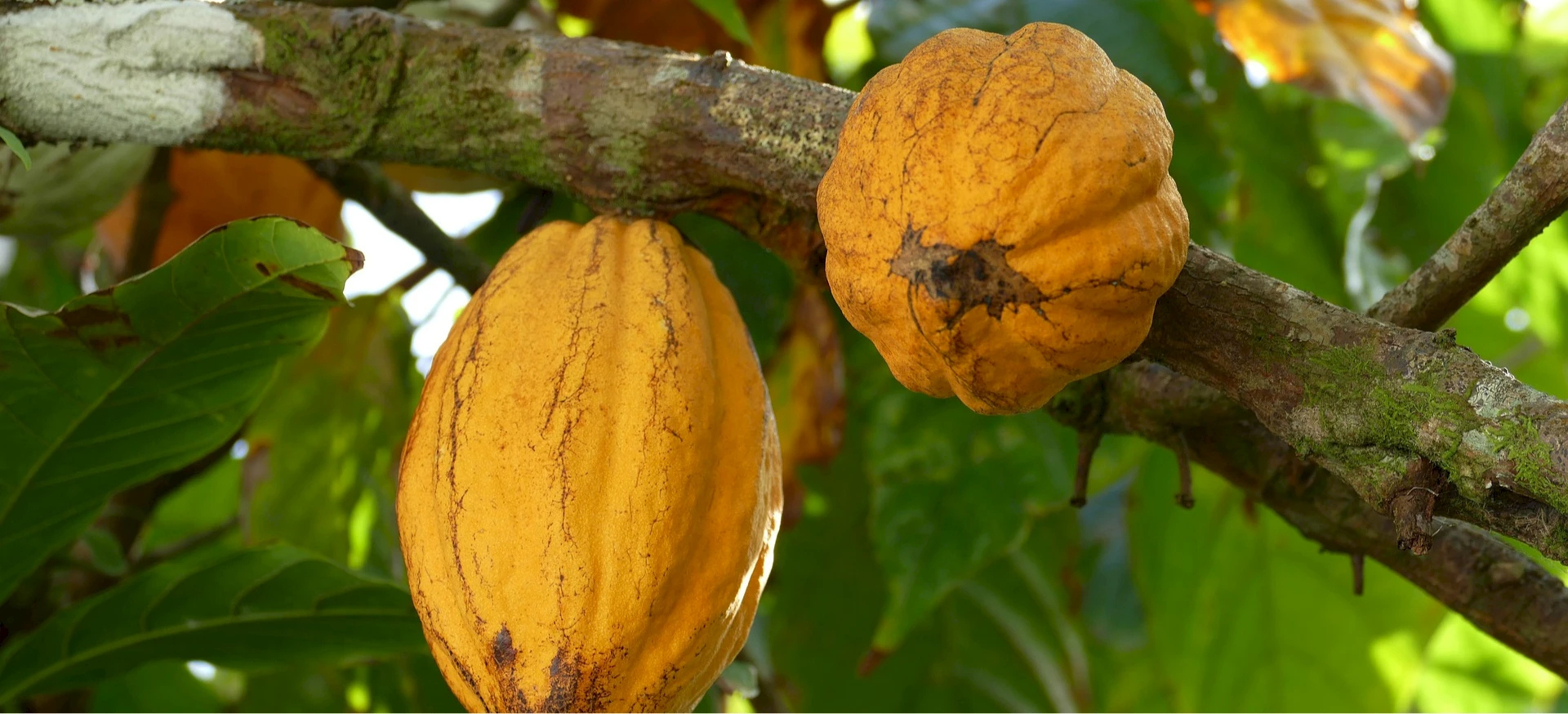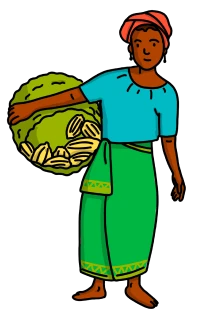METHODOLOGY




第 5 版 世界チョコレート成績表 主要な持続可能性問題に関するチョコレート企業のランクとグレード
世界チョコレート成績表の作成方法
世界チョコレート成績表は、主要な持続可能性問題に関してチョコレート企業をランク付けし、評価するものです。世界チョコレート成績表は、Be Slavery Free が調整役を務め、3つの大学、コンサルタント、市民団体[1]がチョコレート業界の変革に取り組んでいます。
[1] NGO(非政府組織)とも呼ばれます。
ご参加いただいた企業、そしてお時間を割いていただいたスタッフの皆様感謝いたします。
この調査は、チョコレートのサプライチェーンに関わる企業が、持続可能性の成果を向上させるために取り組んでいる方針やベストプラクティスの発展を対象にしています。世界チョコレート成績表は、購入するチョコレートに関する情報を求める消費者や、企業のパフォーマンスを理解しようとする投資家や利害関係者にとっての情報源です。参加企業の人権や環境問題への取り組みを評価し、業界全体の改善に向けた企業の方針や慣行を強化するための生産的な対話を促進することを目指しています。多くの企業は、世界チョコレート成績表を使用して、持続可能性のための独自のロードマップを開発しています。
世界チョコレート成績表は、ブルントラント委員会持続可能性の定義を使用しています。
将来の世代が自らのニーズを満たす能力を損なうことなく、現在のニーズを満たすこと。
世界チョコレート成績表(第5版)は、科学的根拠に基づく目標イニシアチブ(SBTi)、 カーボン・ ディスクロージャー・プロジェクト(CDP) 、 アカウンタビリティ・フレームワーク(AFi)、国際カカオ・イニシアチブ、持続可能なカカオに関する欧州イニシアチブの質問に沿ったものとなっています。
世界チョコレート成績表の年間サイクル

参加とデータ収集
第5版のアンケートを作成し(セクション2参照)、第4版からの参加企業すべてに送付しました。第5版では、世界チョコレート成績表への参加を要請された企業は、第4版の43社に対し、85社でした。選ばれた企業には、業界最大のカカオ取引業者とチョコレートメーカーがすべて含まれていました。これらの企業のカカオの購入量を合わせると、世界のカカオの90%以上を占めます。彼らは人々や地球に大きな犠牲を払わせるか、大きなプラスの影響を与えることができます。
北米の評価対象企業
アメリカ合衆国
ヨーロッパの評価対象企業
ベルギー、フィンランド、フランス、ドイツ、イタリア、オランダ、ノルウェー、スウェーデン、スイス、トルコ、イギリス
アジアの評価対象企業
インド、日本、マレーシア
アフリカの評価対象企業
オセアニアの評価対象企業
オーストラリア
ニュージーランド

90%
世界のカカオの90%は、これらの企業によって買い付けられています
63
参加企業の総数
38
中・大規模企業
9
小規模企業
16
小売業者

機密性とデータ保護
本調査は、以下のヒト研究倫理委員会のガイドラインに従い、以下のプロジェクト名で実施されています。
- マッコーリー大学(オーストラリア・シドニー)からのチョコレート・スコアカード(プロジェクトID:10917、2022年)
- オープン大学(英国)ヒト研究倫理委員会/4275/ベルナルディ
- ウーロンゴン大学ヒト研究倫理委員会、プロジェクト名:世界チョコレート成績表、番号:2022/009
このプロセスは、調査が正直、厳格かつ透明で、敬意を表し、参加者を保護し、調査チームが人間の参加者を含む純正な調査おいて最も現代的な倫理基準を遵守していることを示しています。機密性の高い調査データは、マッコーリー大学の調査データ機密性、セキュリティ、保管ガイドラインに従い、安全なシェアポイントプラットフォーム上に保管されます。
オンラインアンケートへのリンクは、参加企業の主要担当者に電子メールで送信されました。参加者の職務には、CSR(企業の社会的責任)マネジャー、プロジェクト・マネジャー、環境・衛生・安全マネジャー、最高執行責任者(COO)、最高経営責任者(CEO)、持続可能性・人権担当取締役/マネジャーが含まれますが、これらに限定されるものではありません。
参加者は、2023年11月5日から2024年1月24日の間にアンケートに回答するよう求められました。参加者にはアンケートを開始する前に、調査プロジェクトの概要の詳細な説明がなされ、関与への同意が求められました。また、参加者が研究が倫理基準に違反しているとみなした場合の苦情メカニズムについても説明を受けました。
中・大企業の参加
アンケートを送付後、合計17社が参加しないことを選択しました。
以下の中規模企業と大規模企業が不参加を表明しました。
· ゼネラル・ミルズ(3年目)
· クルーガー・グループ
· JBココとグリコ(アジア/日本)
私たちは、彼らの不参加を透明性の欠如とみなしています。私たちは、チョコレート製品を販売するすべての企業がアンケートで要求された情報を提供できるはずだと考えています。消費者と投資家は、チョコレートがどのような条件下で生産されているのかについて知る権利があります。
ユニリーバとモンデリーズの復帰を歓迎します。私たちは、中・大企業企業向けスコアカードに新規企業フリースランド・カンピーナ、デリカAGを歓迎し、彼らの参加に感謝いたします。
小売業者の参加
私たちは、小売業者がチョコレート製品に自社名とロゴを記載するということは、人権と環境問題に対処するために必要なデューデリジェンスを行う義務と責任を、他のチョコレートブランドと同じく負うと信じています。小売業者へのアンケートは2年に1度実施しています。第4版は29の小売業者に送られました。小売業者の大半が大手企業と同じアンケートに回答するために必要なデータにアクセスしていないことを学びました。彼らは、メーカーや取引業者のにデューデリジェンスを任せたり、「外注」することが多く、自社ブランドのプライベートラベルチョコレートに関して回答できませんでした。
小売業者がより強力なカカオの持続可能性プログラムへと移行するのを支援するため、小売業者による年次参加に移行し、小売業者専用の個別のアンケートを設計しました。
このアンケートに含まれる内容
1. 企業のアンケートからの質問の半分以下。小売業者に最も関連性がある質問。
2. 特に小売業者のために設計された追加質問(市販されている彼らの他のチョコレート製品に関連するデューデリジェンスなど)
プライベートラベルメーカーも、企業のスコアカードに参加することができます。プライベートラベルメーカーは、「自社ブランド」メーカーと同様のサプライチェーンがあります。多くのプライベートラベルメーカーは、自社が製造するプライベートラベル製品に加えて、自社ブランドも販売しています。私たちはすべてのメーカーとブランドを同じように扱い続けています。
小売業者固有の質問は、小売業者や専門知識を持つコンサルタントの意見を取り入れて作成されました。このアンケートは、2023年9月に参加小売業者すべてに提供され、協議が行われました。
参加を辞退した小売業者
- 米国からのすべての招待小売業者、すなわちコストコ、クローガー、ウォルグリーン、ウォルマート、ホールフーズなど、米国からのすべての招待小売業者
- ザ・ウェアハウス、フードスタッフなど、ニュージーランドで所有されているすべての招待小売業者
- カジノ、REWE、テスコ、メトロ(ヨーロッパ/英国)
- Sセブン&アイ・ホールディングス(日本)
今年は新たにEDEKAとMigros Retailの参加を歓迎し、彼らの参加に心から感謝いたします。
小規模企業の参加
多くの小規模チョコレート企業が世界チョコレート成績表への参加に関心を示しました。これらのブランドの多くは、重要なセールスポイントとして持続可能性を掲げています。世界チョコレート成績表チームが参加に興味を示した多くの企業をサポートし、評価することは現実的ではありません。
また、場合によっては、企業の規模が介入策や基準の種類に直接影響を与える可能性があるという一貫したフィードバックもありました。
異なる規模の企業の比較可能性という懸念に確実に対処し、小規模企業の革新的な成果を紹介するために、小規模企業を中規模/大手企業から分離し、小規模企業のスコアカードのしきい値は、年間10MTのカカオとしました。私たちは今後1年間、彼らの優れた成果を促進するために、これらの企業のいくつかにスポットを当て、紹介していきます。
チョバチョバ、チョコレートメーカーズ、エレメンツ・トリュフ、ガレー・チョコレート、マルメ、有楽製菓などの小規模企業の参加を歓迎し、感謝いたします。
サポート
参加者にはいくつかの方法でサポートが提供されました。
調査チームは、説明ウェビナー(オンデマンドで利用可能)を作成し、ウェブサイト上で完全なアンケート、用語集、および関連調査を公開しました。企業とのグループQ&A Zoomミーティング(異なるタイムゾーンで提供)を開催し、12月15日までに草案を提出した企業へのフィードバックを提供し、企業との個別Zoomミーティングを開催して質問に回することをしました。13社以上の企業が、調査チームの一部または全員との個別ミーティングを開催する(企業によっては複数回開催)選択を行いました。成績表チームは、企業と数多くのメールのやり取りを行いました。
質問項目の作成
世界チョコレート成績表は6つのカテゴリーを取り扱っています。
これらは、今日のチョコレート産業が直面している最も差し迫った、基本的な持続可能性の分野であることから選ばれました。
質問項目の開発は、いくつかの要因によって決定されました。コアチームは、NGOや主題の専門家との協議を含め、過去の質問の徹底的な見直しを行いました。すべての参加企業には、企業が合理的に答えることができる重要かつ適切な質問をしていたことを確認するために、質問にコメントする機会が提供されました。
質問は編集されましたが、全体的なカテゴリーに変わりはありません。ジェンダーに関する新しい質問が横断的なテーマとして追加され、6つのカテゴリーのそれぞれに質問が追加されました。
第4版と同様、再び各カテゴリーの最後に他の情報を提供するオプションを企業に提供しました。これは、企業が強調したい野心的または革新的なアプローチを紹介する機会で、「ワイルドカード」と呼ばれます。各セクションで、ワイルドカードはそのカテゴリーの合計スコアの20%を占めています
トレーサビリティ と透明性
国連ビジネスと人権に関する指導原則によれば、企業は、自らの活動を通じて、または他の当事者との取引関係によって生じたあらゆる人権への負の影響について責任を負います。この責任を「外部委託」したり、責任をサプライチェーンの次の段階または別の段階に移したりすることは適切ではありません。そうすると、最終的には責任が農家に転嫁されることになり、公正でも公平でもない考えられない状況を生み出しかねません。
カカオの原産地に関する知識を欠いた企業は(トレーサビリティの問題)、極度の貧困、児童労働の最悪の形態、児童労働、強制労働、森林伐採、またはその他の腐敗行為に関与していないことを真に保証できません。簡単に言えば、見ることができなければ、修正することはできません。このトレーサビリティに関する透明性がなければ、市民社会は企業に責任を負わせることも、企業を支援する方法を発することもできません。透明なトレーサビリティは、他のあらゆる改革と発展のための重要な基盤です。トレーサビリティと透明性は、全体スコアの20%を占めています。このカテゴリーの次の分野の回答を分析しました。
使用されたトレーサビリティの方法
- 直接および間接調達の両方における国、農場団体および農家レベルまでのカカオのトレーサビリティ、および追跡可能なカカオの割合
- 認証制度やその他の方法(企業独自のプログラムなど)が使用されている
- 協同組合/サプライチェーンの公表を含む、追跡可能なサプライチェーンに関する企業による報告の透明性
- トレーサビリティを検証するために使用されたツール
トレーサビリティを採点する際、採点者は以下の点を考慮します。
- トレーサビリティは、サプライチェーンの川下にいる購入者ほど確保が困難であること。
- 豆は、ココアバター、リキュール、パウダーといった豆の派生物よりも追跡しやすい。
- トレーサビリティには、マスバランス、セグリゲーション、「アイデンティティ・プリザーブド」以外にも複数のレベルがあります。これには、専任の農家団体との連携、マスバランスカカオの原産地の一致、農家から農家団体、輸出業者、サプライヤー、工場へのトレーサビリティ、およびサプライチェーンの一部についてのみトレーサビリティを確保するその他の方法などが含まれます。
- サプライチェーンが常に変化していると、100%のトレーサビリティを達成することは困難です。100%に到達した後でも、年によっては97〜98%までしかいかない場合もあるかもしれません。これは、採点上は満点とみなされます。
- 規則や法律はすべての参加企業に同様に適用されるため、採点には含まれません。
生計維持所得
生計維持所得とは
特定の場所にてその世帯の全員が最低限の生活を営むのに必要な純年収。
最低限の生活水準の要素には、食料、水、住宅、教育、医療、輸送、衣類、その他不測の事態への備えを含む必要不可欠なニーズが含まれます。
西アフリカのカカオ農家とその家族の大多数にとって、生計維持所得は現実のものではありません。多くの人が貧困から極度の貧困の中で生活しており、飢餓、栄養失調、健康危機、児童労働や強制労働を含むその他の社会的課題に対して、より脆弱な立場に置かれています。
すでに生計維持所得を得ている農家もいることは認識していますが、農家の圧倒的多数はそうではありません。カカオの低価格がもたらす大きな苦しみと、現在進行中の重要な改革を考慮し、生計維持所得の問題は、個別のカテゴリーを設けて扱うことにしました。このカテゴリーについては、3つの分野で回答を分析しました。
- 西アフリカおよび世界のカカオについて、信頼できる生計維持所得基準価格(LIRF)(フェアトレード、VOICEネットワーク、または同等の信頼できる算定値もしくはより高い価格2のいずれかを設定)を支払う方針、および/または算定値を持ち、調達先の農家に追加の奨励金を支払うことを確約している(または支払っている)こと。
- 調達先の地域社会と協議の上決定した、農家の生計維持所得を達成または貧困に対処する企業プログラムを有すること。
- そのようなプログラムの影響を測定し、結果を共有すること。
最高のスコアを獲得したのは以下の企業でした。
- 生計維持所得を基本的人権として認識する声明を出す。
- そのプログラムを基準とするため、実際の生計維持所得計算を使用している。
- ガーナとコートジボワールの政府が定めた生計維持所得格差(LID)と認証済み奨励金に加えて農家に支払いを行っている。
- は開発プロジェクトへの投資は、調達先の地域社会と協議の上決定された開発プロジェクトに投資している。
生計維持所得カテゴリーは、総合スコアの20%を占めています。
2 この特定のスコアカードは、採用されたLIRFのタイプに関しては不可知論的です。しかし、世界銀行の極貧ラインまたは供給国の最低賃金を使用することは、信頼できません
児童労働
NORC決勝 レポート:コートジボワールとガーナのカカオ栽培地域におけるココア生産における児童労働の削減の進捗状況を評価する米国労働省が資金提供したNORC最終報告書:コートジボワールとガーナのカカオ栽培地域における児童労働削減の進展評価によると、以下のことが明らかになりました。
- カカオ生産において児童労働にさらされている子どもは156万人コア生(コートジボワールの約79万人、ガーナの約77万人を含む)
-
148万人の子どもがカカオ生産における危険な児童労働の少なくとも一つの要素にさらされている
- 2008/09年から2018/19年の間に、農薬への曝露がより一般的になり、農薬製品にさらされた子どもの割合は5%から24%へと約5倍に増加しました。
児童労働の撲滅を約束する企業の自主的な取り組みにもかかわらず、児童労働は過去10年間で14%も増加しています。この件に関する具体的な調査は実施されていませんが、新型コロナウィルス感染症が経済、サプライチェーン、学校に及ぼす悪影響によって、一部の子どもが児童労働にさらされる機会が増えた可能性もあります。貧困や極端な低所得は、子どもたちが児童労働や危険な児童労働にさらされることにつながり、結果として子どもたちの未来は奪われ、虐待にさらされることになります。チョコレートは、特にイースターやハロウィーンの時期には子どもの楽しみとなることが多いことを考えると、非常に残念です。それはまた、強制労働の蔓延につながる可能性があります。
NORCの報告書(2019年)では、有害な農薬にさらされた児童労働者数が(10%から27%へ)大幅に増加し、負傷、健康への影響、必要な治療のレベル(入院を含む)が高まっていることが明らかにされました。子どもの化学物質への暴露は、「最悪の形態の児童労働」とみなされています。
このカテゴリーについては、3つの分野で回答を分析しました。
- 児童労働政策、監視・是正改善ステムまたはそれに相当するもの(児童労働監視・改善システム:CLMRS)
- CLMRSの対象となる農場の割合
-
児童労働と強制労働に対処するためのプログラムとプロセスをスケールアップする計画の有無
CLMRSは、児童労働に対処する最も一般的な方法です。しかし、私たちは、体系的である児童労働の根本的な原因に一丸となって取り組まない限り、CLMRS自体が児童労働を効果的に撤廃できるとは考えていません。これには、貧困やその他の人権要因が含まれます。
児童労働カテゴリーは、総合スコアの20%を占めています。
森林破壊と気候
カカオは、世界の森林破壊の主な原因です。西アフリカは世界のカカオの80%を生産しており、中でもコートジボワールとガーナが最大の生産国です。これら2か国は、過去60年間で原生林のほとんどを失っており、その割合は、それぞれ約85%と92%にものぼります。森林損失の約3分の1は、カカオ栽培によるものです。2018年には、これらの国は熱帯諸国の中で最も原生林の損失が増加した国でもあります。2020年には、コートジボワールのカカオ栽培地域で、さらに47,000ヘクタールの森林が失われました。
アジアからアフリカ、ラテンアメリカまで、ほとんどどこで採れたカカオでも、気候変動に悪影響を及ぼす森林伐採と結びついて いることが研究で明らかになっています。森林は炭素を吸収しますが、枯れると炭素を放出し、炭素吸収源としての役割を果たさなくなります。また森林は、テナガザルや類人猿など、世界的に最も絶滅の危機に瀕している種の重要な生息地でもあります。
このため、本セクションでは、深刻な気候変動につながる世界の年間温室効果ガス (GHG) 排出量への業界の貢献度にも焦点を当てています。
この問題に取り組むために、コートジボワールとガーナの政府、カカオ・チョコレートの大手企業35社、農家は、カカオと森林イニシアチブ(CFI)を通じてカカオに起因する森林破壊を終わらせるために連携しています。続いて、コロンビアとカメルーンも同様のイニシアチブを展開しています。しかし、まだまだやるべきことがあり、CFIはまだそのすべての約束に応えていません。
CFI のような森林への取り組み以外にも、チョコレート企業はさまざまな気候変動対策を行っており、特に最近の「ゼロへの競争」(総排出量ゼロを目指す)では、チョコレート産業が積極的に取り組んでいます。
このように非常に大きな課題であるだけでなく、その解決に向けた幅広い活動が展開されていることを評価し、森林破壊と気候変動対策は、総合スコアの20%を占めています。
我々は、以下の分野での回答を分析しました。
- グローバル調達における非森林破壊方針の適用、および非森林破壊モニタリング制度を通じて購入したカカオの割合
-
各種基準日以降、森林破壊地域から調達されたカカオの割合
- 供給業社が最近伐採された土地からカカオを調達している証拠への対応方法に関する詳細な計画
- 全社的または科学的根拠に基づく目標を用いた炭素総排出量ゼロを達成するための方針
アグロフォレストリー
カカオは世界中で森林破壊の主な原因となっていますが、逆に地球の再緑化と再野生化の促進剤となる可能性があります。アグロフォレストリーは、農薬漬けの単一栽培とは対照的に、農地景観を回復させる、より生態学的に健全なカカオ栽培の方法です。科学的研究は、堅牢なアグロフォレストリーのカカオシステムは、炭素隔離、土壌と空気の水分保持、および生物多様性などの観点から、地球にとってより優れているものであることを示しています。農家の食糧確保おや収入の多様化にも役立つことが調査により明らかになっています。正しく実施されれば、人、地球、農民、森林、霊長類を含む絶滅危惧種にとっても有益なものとなります。鳥や動物もアグロフォレストリー環境に戻って来るかもしれません。
アフリカでは森林破壊により、匹の大型類人猿、匹のゴリラ、チンパンジー、ボノボゴリラ、チンパンジー、ボノボといった類人猿の生息地の多くが破壊されましたが、霊長類がアグロフォレストリーを通じて再繁殖する可能性を示す証拠がいくつかあります。マダガスカルにて絶滅の危機に瀕しているキツネザルの固有種107種の一部がこのケースに当てはまります。
アグロフォレストリーは、総合スコアの10%を占めています。
このカテゴリーについては、4つの分野に分けて回答を分析しました。
- アグロフォレストリーの方針とその定義
- アグロフォレストリーの方針の適用(世界規模、または西アフリカのみ)
- アグロフォレストリーの方針の評価とモニタリング
- サプライチェーン内の農家が、アグロフォレストリーの栽培方法に移行するための支援と投資
農薬
農業に使用される化学物質が主な原因となっている昆虫の大量絶滅の危機に直面している今、チョコレート会社は現在の方法を再評価し、より持続可能なカカオ農法を採用することが不可欠です。これは、有害な農薬への依存を減らし、代わりにカカオ農業を支援し、強化する慣行に投資することを意味します。化学物質の投入による生産性の向上が、企業がより多くのカカオを調達する手段であってはなりません。それよりも、カカオ業界が持続することや、近隣の河川に飲料や水源を依存することが多い農村の人々の健康、土壌の健康、そして地球全体の健全性を最優先させる必要があります。
そのためには、企業は最も危険な農薬を完全に排除し、農薬の総使用量を減らす方向に進みつつ、農家が危険な化学物質に依存しない農法に移行するのを支援すると同時に、安全な施肥な害虫駆除の方法を通じて、収量と収入を維持できるように支援するべきです。
企業は、接ぎ木や、剪定、手作業による受粉などの非化学的介入や、最も適切な農業生態学の実践、総合的害虫管理(IPM)に関する教育などを重視して、農家の収穫高を増やすべきです。
このカテゴリーについては、3つの分野で回答を分析しました。
- 農薬削減のための目標や方針が明示されているか否か
- サプライチェーンにおける有害農薬の評価と監視、および有害農薬の使用を段階的に廃止するための措置
- 化学薬品に依存しない代替品の採用の支援
農薬管理は、総合スコアの10%を占めています。
採点プロセス
採点チームは、カテゴリー採点者(単一のカテゴリーを評価する)と総合採点者(総合得点を決定する)を含む、各トピックの主題の複数の専門家で構成されています。すべての採点者は、各分野の専門家とみなされています。採点チームメンバーの一覧は、こちらをご覧ください。
採点プロセスは厳格であり、グレーディングとレビューのいくつかの段階を経ました。はじめに、各質問に対する回答案や採点の考慮事項を含む、各カテゴリーの採点に関する調査チームとのワークショップが開催されました。
4段階のアプローチ
1
各カテゴリーの採点者は、まず全企業の回答を個別に評価する
2
カテゴリーの採点者はスコアを比較し、各企業の最終的なスコアに合意する
3
カテゴリー採点者は、他のカテゴリーの採点者と話し合い、必要に応じてスコアを調整する
4
コアチームによるカテゴリスコアに基づいて、各参加企業の総合スコアを決定する
回答が不明確であったり、提供されたユニフォームリソースロケーター(Url)が破損していたり、関連性のないものであったりした場合、採点者は企業に連絡して明確な説明を求めます。
各企業は、個々のカテゴリーごとに「カラースコア」を受け取り、各カテゴリのスコアを合計して「総合スコア」が出されました。あるカテゴリーのスコアが低いと、特定の問題で「レッド」(業界に遅れをとっているという意味)になるだけでなく、企業全体のスコアが下がる可能性もあります。これは、同じようなカラーを持つ企業でも、最終スコアが異なることがあるのはこのためです。
調査コアチームは、主題の専門家からすべての評定とフィードバックを受領後、最終判断を下しました。
総合得点
The Survey

トレーサビリティ と透明性
All other cocoa products (including liquor, butter, powder, chocolate):
- 0-49% = 0 pts
- 50-74% = 2 pts
- 75-100% = 3 pts
(Bonus points for those that buy mostly or only derivatives, because it is more difficult to achieve 100% traceability)
% Direct:
Less than 50% = 0 pts
Less than 60% = 1 pt
Less than 75% = 2 pts
75% or more = 3 pts
Any certification program
Over 25% = 1 pt
Over 50% = 2 pts
Over 75% = 3 pts
Multiple certification programs (2 or more)
Over 25% = 1 pt
Over 50% = 2 pts
Over 75% = 3 pts
For credible program:
Over 50% = 1 pt
Over 75% = 2 pt
Yes without evidence = 0 points.
Yes with evidence = see below.
Date/year:
- 0-2023 = 3 pts
- 2024-2025 = 2 pts
- 2026-2030 = 1 pt
- After 2030 = 0 pts
Percentage:
- 100% = 2 pts
- 75-99% = 1 pt
- 0-74% = 0 pts
Maximum 5 pts
96-100%: 3 points
91-95%: 2 points
86-90%: 1 point
0-85%: 0 points
76-100%: 3 points
61-75%: 2 points
41-60%: 1 point
0-40%: 0 points
61-100%: 3 points
46-60%: 2 points
31-45%: 1 point
0-30%: 0 points
Extra points given for stronger Mass Balance models than basic Mass Balance.
3 extra points may be given if 0 points scored on Q1.7 and Q1.8
71-100%: 3 points 51-70%: 2 points 31-50%: 1 point 0-30%: 0 points
No tools = 0 pts.
Efforts made/tool(s) used but not effective enough = 1 pt
One effective tool used = 2 pts
Multiple effective tools used = 3 pts
No = 0 pts Yes or No, but the information will be provided to civil society by agreement and on request:
Yes, for all countries = 3 points
Yes, for specific countries = 2 points
Partially, for specific countries = 1 point
No = 0 points
Yes as a gender strategy = 2pts
yes if mentioned in overall strategy = 1 pt
no = 0 pts
Yes with evidence = 2 pts
Yes without evidence = 0 pts
No = 0 pts
If Yes with evidence: reward companies for good percentage with maximum +1 pt.
Maximum 3 pts
Yes with evidence = 2 pts
Yes without evidence = 0 pts
No = 0 pts
If Yes with evidence: reward companies for good percentage with maximum +1 pt.
Maximum 3 pts
For Q1.17 and subsequent questions about Tier 1 suppliers: divide the Tier 1 suppliers for these answers by the Tier 1 suppliers in Q1.16 to get the % of suppliers for grading.
0% of Tier 1 suppliers = 0
>0-25% = 1
>25-75% = 2
>75-100% = 3
If less than 75% then the maximum score for the traceability section is orange.
The answer for Q1.18 divided by the answer for Q1.17 (share of total Tier 1 suppliers)
0% = 0
>0-25% = 1
>25-75% = 2
>75-100% = 3
Adjust the score for Q1.17 and Q1.18 based on this answer by a maximum of 1 point for each question, up to 3 points total.
No response = 0
Supplier code or equivalent = 1
Supplier code plus compliance audits plus mechanism to resolve non-compliance = 2
Supplier code, compliance audits plus direct engagement, or certification = 3
Scoring flexibility for answers that don't fit into this pattern
No = 0
Yes = 1
None = 0 points
1 or more = 1 point
Requesting data from the brand about the supplies: No = 0 points, Yes = 1 point
Checking the certification status of products: No = 0 points, Yes = 1 point
Inquiring whether products in general are covered by the brand’s traceability scheme: No = 0 points, Yes = 1 point
Checking the veracity of ‘sustainability’ or ‘ethical’ claims on packaging and promotion: No = 0 points, Yes = 1 point
Other: Judge based on responses. Max 1 pt.
Maximum 5 pts total
Companies: 11 pts
Small companies: 10 pts
Retailers: 8 pts
(20% of total score for this section)

生計維持所得
Yes = 3 pts
Yes (no evidence) = 0 pts
No/Unknown/No answer = 0 pts
- Policy of non-discrimination only (eg ILO foundational principles) = 1 pt
- Programs which empower women (like a VSLA or the like) = 2 or 3 depending on the scale of the project.
- Number of interventions = 3pts
- Non-discrimination, programs and some affirmative action (eg assisting with land ownership rights) = 4 pts
This question is not scored.
Maximum 0 points.
Refer to Q1.16 for the total number of Tier 1 suppliers.
100% = 2 pts
1-99% = 1 pt
0% = 0 pts
Yes = 5 pts (if paid)
Yes = 1 pt (if included but not paid)
No = 0 pts
If NO then retailer cannot score higher than yellow on Living Income
Yes, if implemented already = max 5 pts
yes, if credible and with target date = 4 pts
No = 0 pts
Above 50%: = 3 pts
Above 30% = 2 pts
Above 1% = 1 pt
0% = 0 pts
Above 50%: = 2 points
Above 1% = 1 pt
0% = 0 pts
Points will also be given for Organic certificaiton.
2 points for showing accurate LIRP calculation
1 point if farmers are paid LIRP
1 point if there is a timebound action plan for farmers to receive a LIRP
Validation question (to validate Q2.9)
Yes = 2 points
No, but we are investigating = 1 point
No = 0 points
Yes (publicly available) = 5 pts
Yes (not publicly available) = 3 pts
No = 0 pts
Companies: 7 pts
Small companies: 7 pts
Retailers: 7 pts
(20% of total score for this section)

児童労働
Yes (with evidence) = 3 points
Yes (no evidence or misunderstanding of eliminating child labor) = 0 pts
No = 0 pts
Yes (with evidence) = 5 points
Yes (no evidence or misunderstanding of eliminating child labor) = 0 pts
No = 0 pts
Yes and URL link provided = 3 points
Yes but no evidence = 1 point
No = 0 points
Yes with evidence = 2 points
Yes without evidence = 0 pts
No = 0 points Retailers:
Yes with evidence = 8 points
Yes without evidence = 2 pts
No = 0 points
No points. Used for validation.
Only score points if this shows impact, not effort.
Any points to be added to the wild card question.
% of total sourcing:
80-100% = 3 points
60-79% = 2 points
40-59% = 1 point
< 39% = 0 points
Number of households is not scored - Needed to calculate cases and reduction in the next questions.
If credible = 3 points
If not credible = 0 points
Credibility is based on overall volume (see section 0) and number of households (Q3.7). Indicator: 2 kids per MT of cocoa, or 2 kids per household or more.
If answered with a credible number = 5 pts
If not answered = 0 pots
Any credible number = 3 pts
A non-credible number = 0 pts
No = 0pts
A credible number would be around 15-20% or higher of children identified
For a realistic number = 5 points awarded for transparency.
Guidance:
- within 3 years 50% should no longer be in child labor.
- a 10% reduction or higher would score points.
Yes and credible = 5 points
No = 0 points
Credible evidence = 5 points (maximum).
Scores can be 0-1-2-3-4-5.
Highest scores for impact evaluations and not just participation evaluations.
Lowest scores for pilots with no evaluation processes.
Yes and URL link provided = 2 points
Yes but no evidence = 1 point
No = 0 points
Companies: 11 pts
Small companies: 9 pts
Retailers: 8 pts
Worth more than 20% for retailers because retailers were not asked many questions

森林破壊と気候
Yes with evidence = 3 points.
Yes without evidence = 0 pts
No = 0 points
Own brand only = 3 pts
Both own brand and branded products = 5 pts
No = 0 pts Maximum 5 pts
No answer: Can only score a maximum of yellow on deforestation section
Refer to Q1.16 for the total number of Tier 1 suppliers.
0% = 0
>0-25% = 1
>25-75% = 2
>75-100% = 3
No response = 0
Supplier code or equivalent = 1
Supplier code plus compliance audits plus mechanism to resolve non-compliance = 2
Supplier code, compliance audits plus direct engagement, or certification = 3
Flexibility for answers that don't fit into this pattern
80-100% = 3 points
60-79% = 2 points
40-59% = 1 point
< 39% = 0 points
Already accomplished = 3 pts
2024-2025 = 2 pts
2026-2030 = 1 pts
2031 or beyond = 0 pts
100% deforestation free: add 3 pts
Maximum 6 pts
0-2013 = 5 pts
2014-2016 = 4 pts
2017-2018 = 3 pts
2019 through Dec 30, 2020 = 0 pt (EUDR compliance)
2021 or later = 0 pts
If multiple dates then the latest date is scored.
Third-party service providers = 1 pt
Internal company systems = 1 pt
Other = add up to 1 pt if equivalent to internal company system or third-party service provider, to a maximum of 2 pts total
No monitoring = 0 pts
Yes - remote sensing = 3 pts
Yes - waypoint mapping and/or
Yes - Polygon mapping = 1 pt
Every 6 months: selected and verified = 1 pt
Every year: selected and verified = 1 pt
Every 2 years: selected and verified = 1 pt
As and when necessary: selected and verified = 1 pt
Never: 0 pts
Other (add):
- selected and verified = 1 pt
- No answer: 0 pts
- Maximum 1 pt
% Sources where the deforestation status of the cocoa is unknown
0-5% = 3 pts
6-10% = 2 pts
11-15% = 1 pt
16% and over = 0 pts
Yes with evidence = 3 pts
Yes without evidence = 0 pts
No = 0 pts
Yes with evidence = 3 pts
Yes without evidence = 0 pts
No = 0 pts
Yes with evidence = 3 pts
Yes without evidence = 0 pts
No = 0 pts
if any percentage between 10-50% is provided, 1 point; if 51-100%, 2 points
Maximum 5 pts
- Yes, we have a climate transition plan which aligns with a 1.5°C world - Selected and verified = 2 points
- No, but our strategy has been influenced by climate-related risks and opportunities, and we are developing a climate transition plan within two years - Selected and verified = 1 point
- No, our strategy has been influenced by climate-related risks and opportunities, but we do not plan to develop a climate transition plan within two years - Selected and verified = 0 points
- No, and our strategy has not been influenced by climate-related risks and opportunities- Selected and verified = 0 points
- Other - If valid and equivalent to 1.5 degree strategy: selected and verified = 2 points
- No answer – 0 pts Evidence needed for points to be given.
Maximum 2 pts
- Yes, and this target has been approved by the Science Based Targets initiative: Selected and verified (https://sciencebasedtargets.org/companies-taking-action#dashboard) = 5 points
- Yes, we consider this a science-based target, and the target is currently being reviewed by the Science Based Targets initiative: Selected and verified (https://sciencebasedtargets.org/companies-taking-action#dashboard) = 3 points
- Other: If credible, verified AND equivalent to answer A = 5 points. If not = 0 points
- Any other answer = 0 pts
Evidence needed for points to be given. Maximum 5 pts
- Yes, and this target has been approved by the Science Based Targets initiative: Selected and verified (https://sciencebasedtargets.org/companies-taking-action#dashboard) = 5 points
- Yes, we consider this a science-based target, and the target is currently being reviewed by the Science Based Targets initiative: Selected and verified (https://sciencebasedtargets.org/companies-taking-action#dashboard) = 3 points
- Yes, we consider this a science-based target, and we have committed to seek validation of this target by the Science Based Targets initiative in the next two years: Selected = 2 points
- Yes, we consider this a science-based target, but we have not committed to seek validation of this target by the Science Based Targets initiative within the next two years: Selected = 1 point
- No, but we are reporting another target that is science-based: If credible and equivalent to answer A = 5 points. If not credible and equivalent = 0 points
- No, but we anticipate setting one in the next two years: If selected = 1 point
- No, and we do not anticipate setting one in the next two years = 0 pts
- Other: If credible and equivalent to answer A = 5 points. If not credible and equivalent = 0 points
- No answer = 0 pts
Evidence needed for points to be given. Maximum 5 pts
Yes with evidence = 3 points
Yes without evidence = 0 pts
No = 0 points
Companies: 13 pts
Small companies: 12 pts
Retailers: 12 pts
(20% of total score for this section)

アグロフォレストリー
Maximum of 3 points (irrespective of the number of countries) with:
a) 0 points if no policy in any country,
b) between 1 and 3 points depending on how many countries (out of the total list of source countries listed) are covered by an AF policy, and
c) 2 points is global AF policy cover all source countries.
Max 5 pts for the current % 0 if AF is not used in any country,
1 for 1-20%,
2 for 21-40%,
3 for 41-60%,
4 for 61-80% and 5
for 81-100 %.
Target % and When (year) are scored in Q5.5.
Maximum 15 pts total.
- Adult trees per ha: Maximum 3 points. If answers given for multiple countries/rows: use the average to score.
- 0 -15 trees/ha = 0 point,
- 15-30 = 1 point,
- 30-50 = 2 points,
- >50 = 3 points.
- % crown coverage: Maximum 3 points. If answers given for multiple countries/rows: use the average to score
- 0-5% = 0 point,
- 5-10% = 1 point,
- 10%-30% = 2 points,
- >30% = 3 points.
- # of tree species per ha: Maximum 3 points. If answers given for multiple countries/rows: use the average to score
- 0-3 = 0 point,
- 3-8 = 1 point,
- 8-12= 2 points,
- >12 = 3 points
- % native species: Maximum 3 points. If answers given for multiple countries/rows: use the average to score.
- 0 for open-sun cocoa,
- 1 point for 1-25% of native species,
- 2 points for 26-50% of native species,
- 3 points for ≥51% of native species.
- Number of vertical strata: Maximum 3 points. If answers given for multiple countries/rows: use the average to score
- 0 point for open-sun cocoa,
- 1 point for shade canopies with 1 shade stratum,
- 2 points for shade canopies with 2 strata,
- 3 points for ≥ 3 strata.
0 pts when no support is given to farmers,
1 pt when only training is provided,
2 pts when on-farm advice is provided, and
3 pts when monetary support (alone or in combination with training or on-farm advice) is provided.
If answered for multiple countries or regions: If any of the above are provided anywhere then the points are given (it does not have to be for multiple countries).
Maximum 3 pts.
Maximum 7 points for small companies and medium/large companies
Maximum 4 points for retailers
Worth more than 20% for retailers because they are only asked Q5.1.

農薬
100% with evidence = Full points for the entire Pesticide section. The remaining questions do not need to be answered or scored.
No = 0 points and continue with the remaining questions for section 6
Yes (published policy) = 3 pts
Yes (no evidence) = 0 pts
No = 0 pts
Confectionery: 2 pts.
If one or more others are included: add 2 pts
Max 4 pts
Refer to Q1.16 for the total number of Tier 1 suppliers.
0% = 0
>0-25% = 1
>25-75% = 2
>75-100% = 3
Evaluated for a mix of compliance (eg certified organic, audits) and support (eg technical expertise, dialogue, etc).
Maximum 3 pts
- Aligned with external certification programs + additional company requirements = 3pts
- Aligned with external certification programs only (if it applies to at least 90% of sourcing) = 2 pts
- Aligned with external certification programs only (less than 90% of sourcing) 1pt
- Company strategy only – score according to content.
- Aligned with external certification programs only (less than 100% of sourcing) 1pt
- No or No answer = 0 pts
Note: this question can only add points to the score for Q6.5, up to a maximum of 3 pts for Q6.5.
Yes – uses RA/FT lists and own lists beyond those – 3 pts
Yes with proof that it uses external certification program lists = 2 pts
Yes with another credible list = 2 pts
Yes but without evidence = 0 pts
No or No Answer = 0 pts
Uses additional lists beyond external certification program lists = 3 pts.
If using only company lists and these cover not only acutely toxic to humans but also chronic health effects and/or environmental effects = 2 pts.
If using only company lists, and these cover only acutely toxic to humans = 1pt.
Yes, but no evidence provided = 0 pts.
0.5 points for each answer selected.
Round the total to the nearest whole number (integer).
Only whole numbers given as the final score.
Maximum 3 pts
0.5 points for each answer selected.
Round the total to the nearest whole number (integer).
Only whole numbers may be given as the final score.
Maximum 3 pts
IPM trials or research = 1 pt.
Farmer training on IPM or non-chemical methods = 1 pt.
Provision of or support for access to biological pesticides or botanical extracts or tools or labour for cocoa tree pruning or grove renewal = 1 pt.
Mention of PAN International HHP List = 1 pt.
Mention of HHPs = 1 pt.
Mention of any specific active substances or groups (e.g. neonicotinoids or those harmful to bees) = 1 pt.
Maximum 3 pts.
0.5 points for each topic mentioned.
Round the total to the nearest whole number (integer).
0.5 points for each topic mentioned.
Round the total to the nearest whole number (integer).
Details on measures to remove/remedy soil contamination by these metals = 2 pts
At the stage of identifying contamination hotspots or making a reduction plan or conduct residue testing = 1 pt
No = 0 pts
Companies: 7 pts
Small companies: 4 pts
Retailers: 5 pts
(20% of total score for this section)
